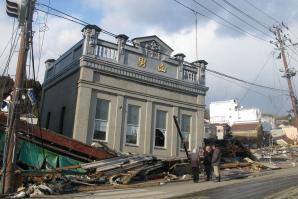Although the United States Army Corps of Engineers is the largest public engineering, design and construction management agency in the world, most Americans identify it with flood protection. This is particularly true in the Sacramento Region, where the Corps is heavily involved in virtually every major flood control system. We sat down recently with Corps Director of Civil Works Steve Stockton, the agency’s highest ranking civilian, in his Washington, D.C. office to discuss the challenges of flood prevention and the agency’s interest in partnering with the private sector.
Comstock’s: Flood control is a complex and often confusing issue for most people. What is the Corps’s role in flood control management in comparison to local and state responsibilities?
Stockton: First, we’ve changed our terminology from ‘flood control’ to ‘flood risk reduction.’ This came out of the post-Katrina era because what we had down there [in the Gulf] we called a hurricane protection system, but it really wasn’t a complete system and didn’t provide protection against all storms of all sizes. With structural measures like levees, we can protect against the normal and even very large storms and floods, but there’s always a bigger storm out there.
But to your question, risk reduction is a shared responsibility between the federal, state and local governments. It is also a shared responsibility with local land-use planners because in a lot of cases decisions are made that put people in harm’s way, that put people in flood plains, and those are really local decisions. Developers come in and develop property and then transfer that property to owners who are then the ones left with the flood risk. The federal government doesn’t have much of a role in making local land-use decisions.
Comstock’s: You don’t control the locals, but how much do some of their decisions impact Corps policies? California, for instance, has taken steps to limit development in flood plains. Has this impacted the Corps’ flood control policies?
Stockton: When we evaluate a project, it’s for what it is at that point in time. We don’t look at future development, future benefits or the negative consequences of future development. We basically look at it and ask three things: ‘Is the federal investment to reduce the flood risk at that time economically viable? Is it environmentally acceptable? And is it technically feasible?’ Then we make investment recommendations to the administration and Congress. It’s really political decisions that the administration and Congress make on what projects to fund or not fund.
Comstock’s: Another significant issue in Northern California is the Corps policy on removing vegetation on levees. What is the current state of that policy?
Stockton: There are three components to it. First, we have an engineering technical letter that defines what our vegetation and levee maintenance standards are. If somebody is in compliance with that, it’s the end of the story. They’re eligible for a federal program that allows disaster response and the federal government to cost-share repairs to levee systems. But recognizing that a lot of these systems are not in compliance, we also allow an entity like the Department of Water Resources or [the Sacramento Area Flood Control Agency] to come in and buy down the highest-risk elements first, recognizing that levee vegetation is often not the biggest risk. So if they’re making progress in correcting underseepage problems or slope stability problems or encroachments on the levee systems, we allow them to stay in the program. As long as they’re making progress, you can put the levee vegetation issues at the end and get to those last. It’s our ‘worst first’ philosophy with respect to risk reduction strategies. The third part of this is the levee vegetation variance. If a nonfederal sponsor believes they can achieve the same level of functionality by doing something differently than the engineering standard, we’re open to looking at those proposals. So we’re trying to be as flexible as we can be, but ultimately we want to achieve either the same functionality or achieve compliance with the standard.
Comstock’s: But given all the ways that levees can fail, and with the limited amount of money available to deal with that, why so much emphasis on the vegetation issue?
Stockton: I think it’s perceived and portrayed that way, but in actuality we are firm believers in buying down the maximum risk factors that expose the system to the greatest risk, whether that’s levee height, underseepage, slope stability or even rodent holes, all of which I would agree are generally larger issues. And if you have constrained funding, which most local and state entities do, you want to be reducing your risk by making smart investments over time. That’s why we’ve developed the system-wide improvement framework process to allow those corrective actions as the last added increment. A lot of it is allowing access so you can see the levee system, so you can monitor it, so you can have access to flood-fight and get in equipment during an event. And if you have excess, large, woody vegetation, you preclude yourself from doing that.
Comstock’s: State and local governments have done significant work on the Natomas Levee Improvement Program, but federal funding has stalled. Without that, the Corps can’t finish its part of this critical flood protection project. My understanding is it was slated to be completed by 2019. Is that still a possibility?
Stockton: Anything the Corps does, we need two things: authorization and appropriations. The shared responsibility for a flood damage reduction project is 65 percent federal and 35 percent local, but you can’t even compete for the appropriations until you get it authorized and that’s the current hang up. We submitted our plan for completing improvements to Natomas’ levees to Congress in 2011, but Congress needs a mechanism to authorize that project at the current cost. They’re struggling with that because of their current ‘no earmark’ policy. There’s a 50/50 chance that we’ll get a new water resources development act in 2013, but they still need to overcome this self-imposed ban on earmarks because you can’t put together a ‘projects-only’ development act without specifying those individual projects. So they’ve kind of got themselves wrapped around the axle. The second piece of that is the appropriation. Once it’s authorized, that project will have to compete nationwide for available funding, which will be based upon a benefit-cost ratio, basically the hazard that’s created by not having that protection in place. So the timeline is dependent upon when the project gets authorized, how much money is appropriated and when it happens. I really can’t speculate on when that might happen.
Comstock’s: You’ve used the word perception a couple of times. Whenever there is a flood, the Corps seems to take a lot of heat for it. At times this is justified, but at others perhaps not. How do you feel about the Corps’ public image?
Stockton: I think we get blamed for a lot of things, some deserved, some not. But in the whole area of flood risk management, it goes back to what I said in the beginning, you can’t control all floods of all sizes. A good example was last year in the Missouri River and the flooding there. We made the best decisions we could with the information we knew at the time, and we reduced flooding by over $8 billion on the Missouri River system. That said, there were still areas that got flooded because you can’t reduce all the risk of a once-in-500-year event. Often times we take the fall for Mother Nature when in fact we can’t protect against all floods of all sizes.
Comstock’s: What are you doing to address those issues? Are there any major changes on the horizon?
Stockton: The biggest complaint we get is that what we do costs too much and takes too long. So we’re looking at how we can do a better job planning and budgeting projects — how we can do them quicker on a watershed scale and funded to completion, how we deliver those products and services from an enterprise scale and then how we manage our infrastructure. We have about a quarter of a trillion dollars in replacement value of infrastructure that we’re responsible for managing, so we’re applying asset management principles so we make the best investments for every dollar we get of federal funding. We’re looking at how we make end-of-life-cycle decisions, since most of our projects were designed with an economic life of about 50 years and a functional life of about 100 years. And then we’re looking at how we can put private capital to work to meet some of the demands that federal funding is just not allowing us to meet. The process we’re using now is unsustainable as an infrastructure strategy. I think the country needs to come to grips with how we can sustain what we’ve got and still make new water resource investments because the nation’s growing and its needs are changing. As an example, most of our shipping locks are over 60 years old. The same goes for dams. I think the nation has a slow growing infrastructure crisis that we’re trying to increase awareness and visibility of, and then trying to come up with some creative solutions for how we can put private capital to work to do what the federal government has been relied upon to do, historically.
Comstock’s: How would the private investment work?
Stockton: That’s what we’re trying to figure out. We’ve got some examples we’re looking at. We’ve had a number of workshops, bringing in investment banks, retirement funds, venture capitalists, and asking how we put together these deals where you can use private capital to make the investment up front, and how you create the funding streams over time to pay back those investments. We’re floating these ideas in our discussions with the Secretary of the Army’s office and the Office of Management and Budget. There’s some interest there, but we would need legislation and authorities to allow us to collect the moneys and then use them for those purposes.
Recommended For You

Waterborne Disorder
In the event of flood, area hospitals are at risk
In the hours before Hurricane Sandy hit New York last year, the country’s oldest public hospital thought it was ready.

Temblor Trouble
Will recent quakes around the world spur policy change in California?
The scenes of twisted metal, splintered wood, crumbling brick and flooded streets are still vivid to Kit Miyamoto, a Sacramento-based engineer who follows earthquake destruction around the world. But he’s not just seeing these images in Haiti, Chile or Japan.



